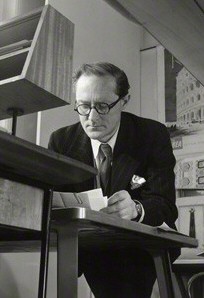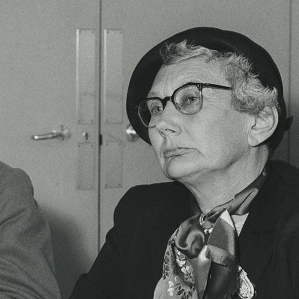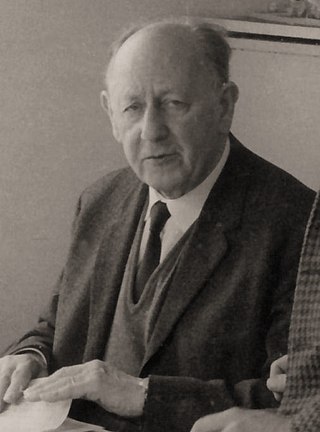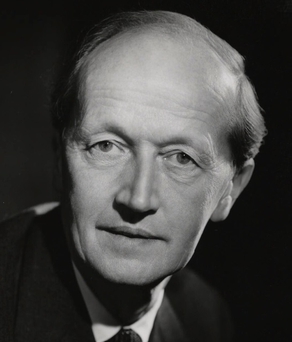Related Research Articles

Kenzō Tange was a Japanese architect, and winner of the 1987 Pritzker Prize for Architecture. He was one of the most significant architects of the 20th century, combining traditional Japanese styles with modernism, and designed major buildings on five continents. His career spanned the entire second half of the twentieth century, producing numerous distinctive buildings in Tokyo, other Japanese cities and cities around the world, as well as ambitious physical plans for Tokyo and its environments.

Sir Denys Louis Lasdun, CH, CBE, RA was an eminent English architect, the son of Nathan Lasdun (1879–1920) and Julie. Probably his best known work is the Royal National Theatre, on London's South Bank of the Thames, which is a Grade II* listed building and one of the most notable examples of Brutalist design in the United Kingdom.

Sir Hugh Maxwell Casson was a British architect, also active as an interior designer, an artist, and a writer and broadcaster on twentieth-century design. He was the director of architecture for the 1951 Festival of Britain. From 1976 to 1984, he was president of the Royal Academy.

Wells Wintemute Coates was an architect, designer and writer. He was, for most of his life, an expatriate Canadian who is best known for his work in England, the most notable of which is the Modernist block of flats known as the Isokon building in Hampstead, London.

Team 10 – just as often referred to as Team X or Team Ten – was a group of architects and other invited participants who assembled starting in July 1953 at the 9th Congress of the International Congresses of Modern Architecture (CIAM) and created a schism within CIAM by challenging its doctrinaire approach to urbanism.

Berthold Romanovich Lubetkin was a Georgian-British architect who pioneered modernist design in Britain in the 1930s. His work includes the Highpoint housing complex, the Penguin Pool at London Zoo, Finsbury Health Centre and Spa Green Estate.

Dame Sylvia Crowe, DBE was an English landscape architect and garden designer.
The Modern Architectural Research Group, or MARS Group, was a British architectural think tank founded in 1933 by several prominent architects and architectural critics of the time involved in the British modernist movement. The MARS Group came after several previous but unsuccessful attempts at creating an organization to support modernist architects in Britain such as those that had been formed on continental Europe, like the Union des Artistes Modernes in France.

The Athens Charter was a 1933 document about urban planning published by the Swiss architect Le Corbusier. The work was based upon Le Corbusier’s Ville Radieuse book of 1935 and urban studies undertaken by the Congrès International d'Architecture Moderne (CIAM) in the early 1930s.

Ashlyns School is a mixed secondary school and sixth form located in Berkhamsted, Hertfordshire, England. The school was established in 1935 as the final location of the Foundling Hospital, a children's charity founded in London in 1739. The Berkhamsted building converted into a school in 1955. Ashlyns School is noted as an example of neo-Georgian architecture and is a Grade II listed building.
Philip Morton Shand, known as P. Morton Shand, was a British journalist, architecture critic, wine and food writer, entrepreneur and pomologist. He was the paternal grandfather of Queen Camilla.
John Brandon-Jones was a British architect. His work was heavily influenced by the Arts and Crafts movement, of which he was a noted architectural historian.
Dame Jane Drew, was an English modernist architect and town planner. She qualified at the Architectural Association School in London, and prior to World War II became one of the leading exponents of the Modern Movement in London.

Structuralism is a movement in architecture and urban planning that evolved around the middle of the 20th century. It was a reaction to Rationalism's (CIAM-Functionalism) perceived lifeless expression of urban planning that ignored the identity of the inhabitants and urban forms.

Arthur Korn was a German architect and urban planner who was a proponent of modernism in Germany and the UK.

John Harold Westgarth Voelcker was an English architect. A member of the Team 10 group of architects, he ran a small rural practice before his appointment first Professor of Architecture at the University of Glasgow.

Lionel Gordon Baliol Brett, 4th Viscount Esher, 4th Baron Esher CBE was a British peer, architect and town-planner. He succeeded to his title on the death of his father in 1963.

Henry Thomas Cadbury-Brown RA, also known as H.T. Cadbury-Brown and Jim Cadbury-Brown, was an English architect. He was educated at the Architecture Association where he was influenced by the architecture of Le Corbusier and Walter Gropius. After graduating he worked for architect Ernő Goldfinger and became his lifelong friend. He went on to set up his own successful practice.
Hubert de Cronin Hastings, often referred to in contemporary works as H. de C. Hastings, was chairman of the Architectural Press and editor of Architectural Review and Architects' Journal.

Edith Schreiber-Aujame was a Franco-American architect and urban planner. She was born in Rymanów, Poland and died in France.
References
- 1 2 3 4 5 6 7 Kerr, Joe (10 February 1997). "Obituary: William Tatton Brown". The Independent. Retrieved 28 February 2023.
- 1 2 3 4 5 Obituary: William Tatton Brown, The Times, February 1997
- ↑ "Obituary: William Eden TATTON BROWN", Daily Telegraph, 26 February 1997
- ↑ Gold, John R. (July 1995). "The MARS plans for London, 1933-1942: plurality and experimentation in the city plans of the early British Modern Movement". Town Planning Review. 66 (3): 243–267. Retrieved 2 March 2023.
- ↑ United Kingdom list: "No. 43529". The London Gazette (Supplement). 29 December 1964. pp. 1–36.
- ↑ Construction Research Advisory Council (Membership), Hansard , Volume 754: debated on Monday 13 November 1967. Accessed: 28 February 2023.
- ↑ Building 2814, UK Modern House Index. Accessed: 28 February 2023.
- ↑ Pevsner, Nikolaus; Cherry, Bridget (1983). Issue 25 of Buildings of England: London 2: South. Yale University Press. pp. 252–253. ISBN 9780300096514.